Delicious Cold Pasta Salad From Italy
Caprese Pasta Salad is a modern spin on two classic Italian recipes. In Italy, this dish is known as ‘Insalata di Pasta Caprese’ and combines delicious fusilli pasta that’s cooked al dente and then cooled and add it to key ingredients used in a traditional Caprese salad recipe (Insalata Caprese).
I use a normal mozzarella ball for this recipe and dice it up into bite-sized pieces, but you can always use Mozzarella balls instead. Either way, this salad is ideal for the warm summer months and can be prepared in advance and assembled right before serving, making it ideal for BBQs, picnics, or served as a healthy salad.
The result is a filling pasta salad that is easy to make and sings with Mediterranean flavors from the vinaigrette dressing. This recipe makes a good-sized salad that served 4-6 people as a side dish or 2-3 when served as a main meal.
Table of contents:
How to Make Caprese Pasta Salad (Insalata di Pasta Caprese)
Ingredients
Caprese pasta salad
- 8 oz. (220g) dry pasta (I used Fusilli pasta)
- 8 oz. (220g) mozzarella (fresh cubed mozzarella or mini mozzarella balls)
- 2 cups cherry tomatoes, halved
- 1 ⁄4 cup fresh basil leaves, finely chopped
- Salt and pepper (to taste)
Vinaigrette dressing
- 1 ⁄4 cup olive oil (I used this 100% Italian Sabina DOP Extra Virgin Olive Oil)
- 1 tbsp Balsamic Vinegar
- 2 tbsp fresh lemon juice (around 1 lemon)
- 1 clove of garlic, minced
- 1 tsp Italian Seasoning
- Salt
Equipment Needed
- Cooking pot with lid
- Large Glass bowl
- Cutting board and Chef Knife
- Salad Serving spoons
- Salad Serving platter
Instructions
Step 1 – Cook Fusilli Pasta
- Cook the fusilli pasta according to package instructions. It should take around 9 minutes to become al dente once submerged in boiling water (make sure the water is boiling before adding the pasta).
- Remove pasta from the heat and drain in a colander. Rinse with cold water for a minute or two or until the pasta is cool enough to touch.
- Drizzle with a splash of olive oil and mix through (this stops the pasta from sticking together while we prepare the salad and dressing)
- Set pasta aside to cool.
Step 2 – Prepare Vinaigrette dressing
NOTE: Prepare the Vinaigrette dressing before making the salad so it gives plenty of time for the ingredients to meld.
- In a small bowl, Squeeze the juice from 1 lemon.
- Add the olive oil, balsamic vinegar, minced garlic, herbs, and seasoning. Give everything a mix for 30 seconds or until the ingredients combine.
Step 3 – Prepare Salad
- Add the cooled pasta to a large bowl.
- Halve cherry tomatoes and add to the bowl.
- Chop the mozzarella into small cubes around half an inch (1cm). Add to the bowl with the pasta
- Finely chop around half of the basil leaves and add to the salad ingredients
- Drizzle the dressing over the salad ingredients and mix well with salad tongs.
- Loosely scatter the remaining basil leaves on top of the salad.
Cooking Notes:
- Don’t leave your pasta to soak in cool water as it will absorb liquid and become mushy. Give it a light rinse under cool water, and then set aside in a colander with just a splash of olive oil mixed in.
- Don’t have Italian seasoning? See the information in the article on how to make your own.
- Mozzarella pearls are also great for this recipe.
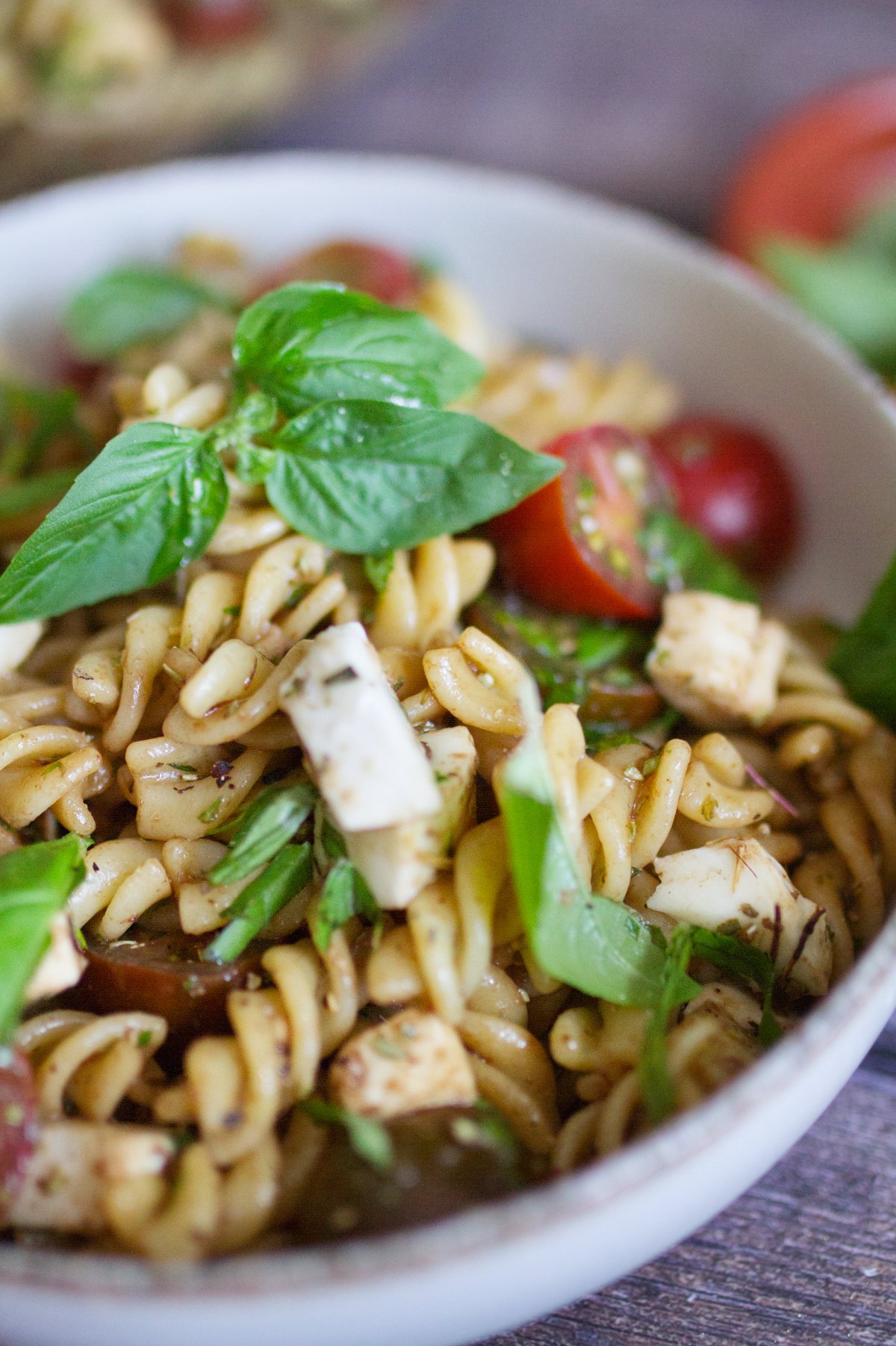
Origins of Caprese Pasta Salad
Ensalada de Pasta Caprese is a variation of the classic Italian Caprese salad, which traditionally consists of tomatoes, fresh mozzarella, basil, olive oil, and salt. The Caprese salad, known in Italy as “Insalata Caprese,” originates from the island of Capri, located in the Campania region of southern Italy.
Ingredients and Substitutions
Pasta
I use fusilli pasta for this recipe as the spiral shape gathers a good amount of the dressing giving each bite a wonderful flavor. You will also want a type of pasta that is visually appealing in a pasta salad (sorry your average Joe Spaghetti won’t cut it for this recipe).
Any other small type of pasta will work just fine. Here are a few pasta suggestions for your caprese pasta salad:
- Fusilli: The spiral shape of the fusilli holds onto the dressing and mixes well with the other ingredients.
- Penne: The tube shape of penne allows it to capture pieces of tomato and mozzarella, ensuring a balanced bite.
- Rotini: Similar to fusilli, rotini’s twisted shape is perfect for holding onto the dressing and mingling with other ingredients.
- Farfalle (Bow Tie): The unique shape of farfalle adds visual interest to the salad and holds the dressing well.
- Orzo: A rice-shaped pasta that can add a nice texture and is easy to mix with the other ingredients.
- Gemelli: These twisted pasta shapes are excellent for trapping the dressing and combining it with small pieces of tomato and mozzarella.
These pasta shapes will help ensure that your Caprese pasta salad is flavorful, well-mixed, and visually appealing.
Mozzarella
Mozzarella is a traditional Italian cheese known for its mild flavor, smooth texture, and excellent melting properties. It is typically made from the milk of water buffalo, particularly in the region of Campania in Italy, though cow’s milk versions are also common and widely available.
Types of Mozzarella
There are a few different types of mozzarella, however, the most common varieties you are likely to find in supermarkets are Fresh mozzarella and buffalo mozzarella. We used fresh mozzarella for this recipe.
- Fresh Mozzarella Ball: Soft, moist, and usually packed in brine or whey. It’s often used in salads (like Caprese), as a pizza topping, or eaten on its own. You’ll find fresh mozzarella packaged in small bags or containers filled with brine. Usually, the ball is around half the weight of the packaging.
- Low-Moisture Mozzarella: Firmer and drier than fresh mozzarella, it’s commonly used in cooking and baking, particularly for pizzas and casseroles.
- Buffalo Mozzarella (Mozzarella di Bufala): Made from the milk of water buffalo, it has a rich, creamy flavor and a slightly tangy taste. It is considered a delicacy and is often used in traditional Italian dishes.
- Smoked Mozzarella (Scamorza): A variant that has been smoked to add a distinctive flavor. This type of mozzarella can be hard to find outside of Italy.
Mozzarella Pearls
Mozzarella Pearls are delicious mini-balls of mozzarella that work great in salads. They’re usually found in the chilled cheese section of the supermarket (typically next to the full-size mozzarella products). They are the same smooth creamy flavor of normal mozzarella, just pearl-sized, or around half in inch (1cm) in diameter.
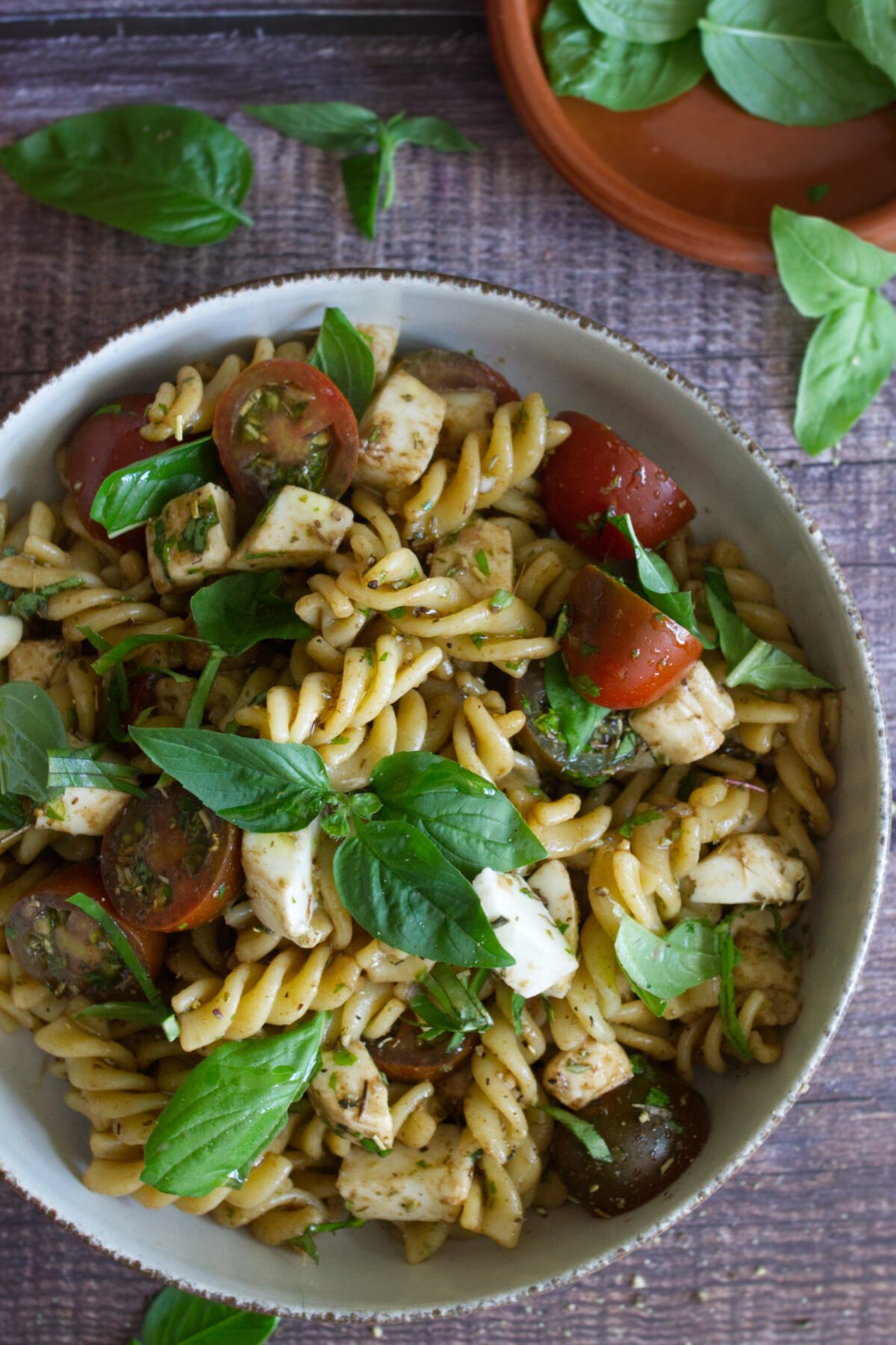
Cherry Tomatoes
The best option for tomatoes will be what is fresh and in season. I use Italian Pomodoro tomatoes as I love the dark color and rich flavor.
Cherry tomatoes do vary considerably in color, and intensity of flavor, with some being much sweeter than others.
Here are some of the best cherry tomato varieties to consider:
- Sweet 100: Known for their intense sweetness and bright red color, these tomatoes add a burst of flavor to any salad.
- Sungold: These are exceptionally sweet and have a beautiful golden-orange color that adds visual appeal to the salad.
- Black Cherry: These tomatoes have a unique, deep purplish color and a rich, complex flavor that can add depth to the salad.
- Grape Tomatoes: Smaller and oblong in shape, grape tomatoes are sweet, firm, and perfect for a Caprese salad.
- Yellow Pear: These tomatoes have a mild, sweet flavor and a lovely yellow color, adding diversity to the salad.
Can I use normal tomatoes instead?
Yep, absolutely! In fact, the classic caprese salad recipe uses large ripe tomatoes that are sliced. There’s no reason why you can’t use a large tomato variety and cut them into bite sized wedges. I would not recommend dicing tomatoes as they will become too mushy in a salad.
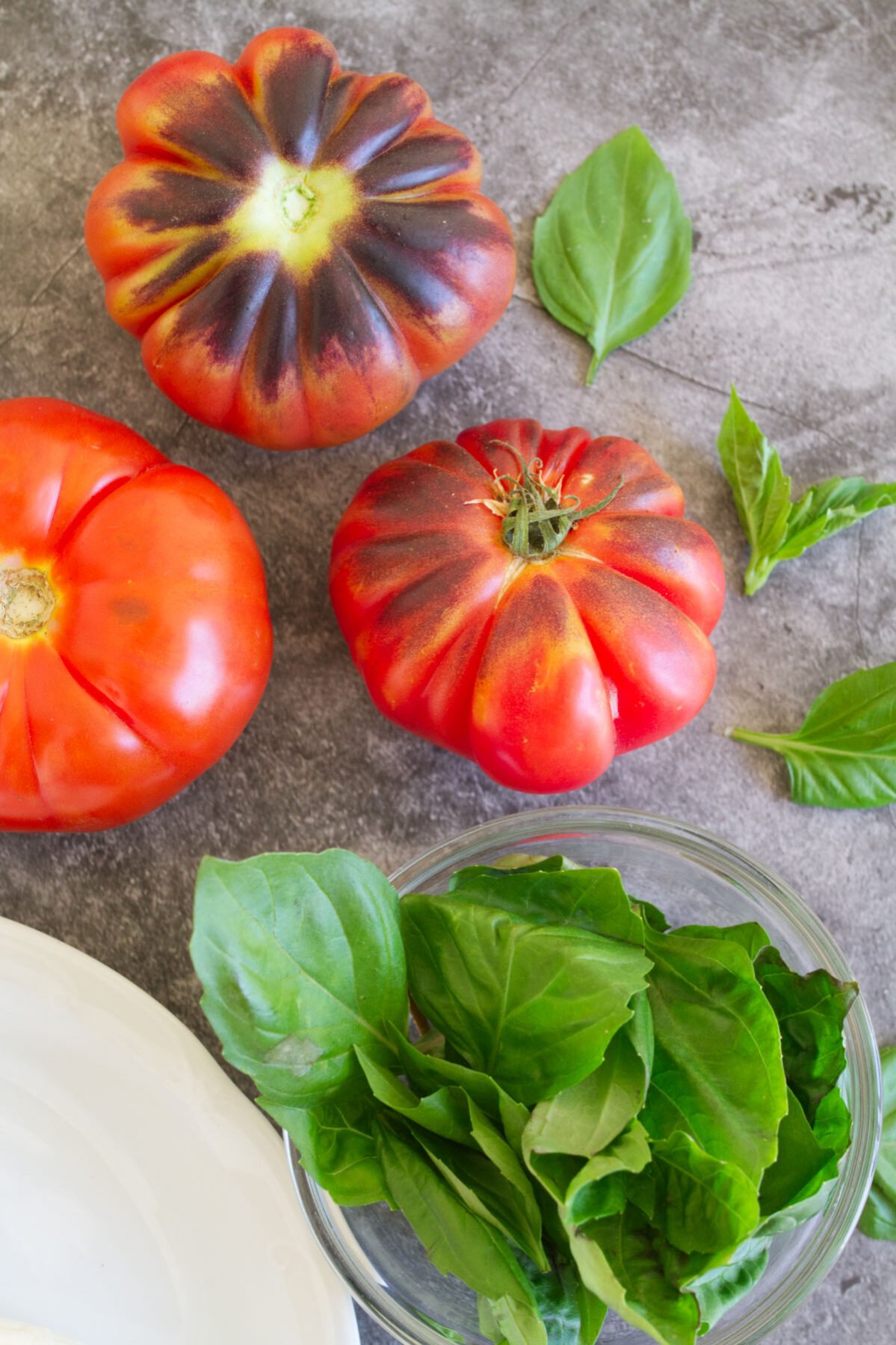
Italian Seasoning
Italian seasoning is a blend of dried herbs commonly used in Italian cuisine. It typically includes a combination of the following herbs:
- Basil: Adds a sweet and slightly peppery flavor.
- Oregano: Provides a robust, earthy taste.
- Rosemary: Offers a pine-like aroma and flavor.
- Thyme: Imparts a subtle, dry, and slightly minty taste.
- Marjoram: Has a sweet, citrusy, and slightly bitter flavor.
- Sage: Gives a warm and earthy taste.
If you don’t have Italian seasoning, it is easy enough to make a mix at home. Combine the following
- 1 tsp oregano
- 1 tsp thyme
- 1 tsp rosemary
- pinch of salt and pepper
The exact proportions and ingredients found in Italian herb mix can vary, but this mix is designed to replicate the flavors commonly found in Italian cooking. Some versions might also include garlic powder, onion powder, or red pepper flakes for added depth and heat. Italian seasoning is versatile and can be used in a variety of dishes such as pasta sauces, marinades, soups, and roasted vegetables.
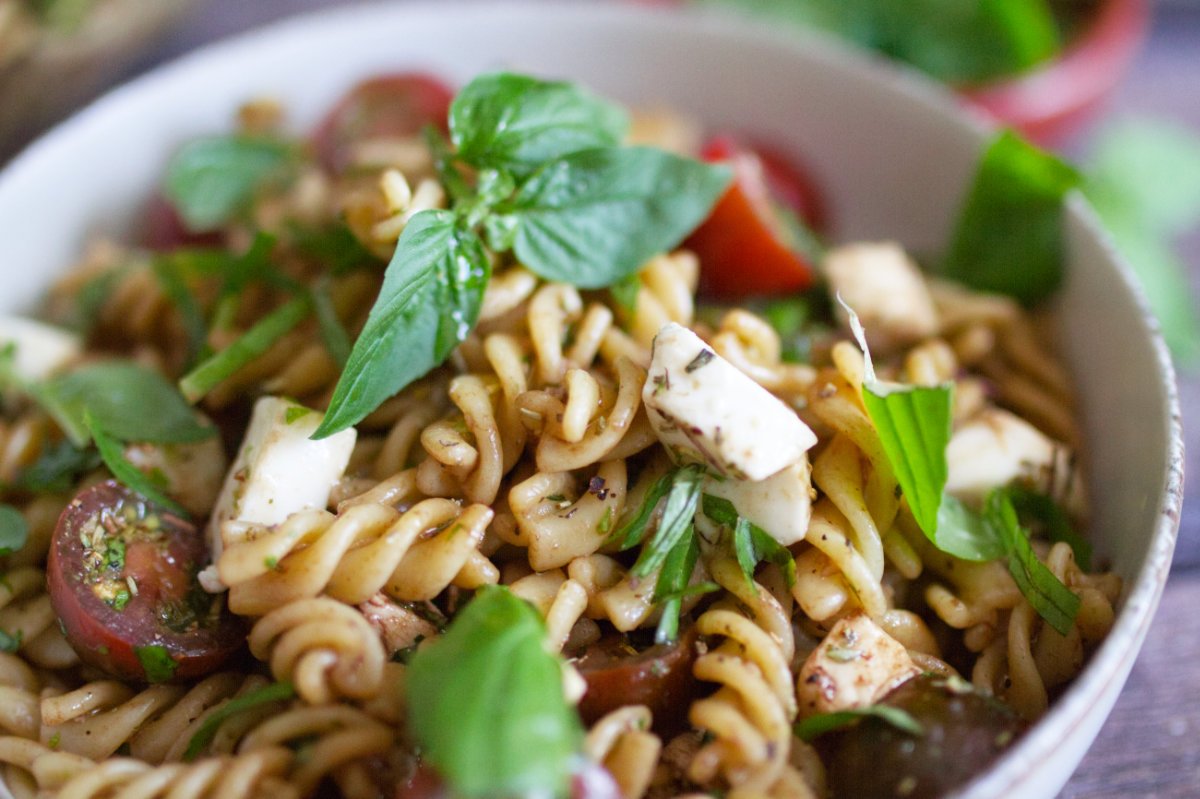
Olive Oil
Good quality olive oil, and in particular Italian extra virgin olive oil, is a staple in Italian cuisine and I highly recommend using the best quality EVOO you can afford for this recipe. Quality EVOOs have a superior flavor, not to mention numerous health benefits!
Balsamic Vinegar
Balsamic vinegar is a type of vinegar that originates from Italy, specifically the regions of Modena and Reggio Emilia. It is made from unfermented grape juice (known as must) that is cooked down to a syrupy consistency and then aged for varying periods in wooden barrels. The aging process imparts a complex flavor profile, combining sweetness, tanginess, and a rich, deep taste.
There are three main types of balsamic vinegar:
- Traditional Balsamic Vinegar (Aceto Balsamico Tradizionale):
- Made from 100% grape must.
- Aged for a minimum of 12 years, but can be aged for up to 25 years or more.
- Bottled in specific, uniquely shaped bottles as a guarantee of authenticity.
- Rich, thick, and complex in flavor with a balance of sweet and sour.
- Balsamic Vinegar of Modena (Aceto Balsamico di Modena):
- A blend of grape must and wine vinegar.
- Aged for a shorter period, typically from a few months to a few years.
- Less expensive and more commonly available than traditional balsamic vinegar.
- Versatile, with a balanced flavor but less complex than traditional balsamic.
- Condiment-Grade Balsamic Vinegar:
- Made similarly to traditional balsamic but doesn’t meet the strict regulations.
- Aged for varying periods and often used as a more affordable alternative to traditional balsamic.
Balsamic vinegar is used in a variety of culinary applications, such as salad dressings, marinades, glazes, reductions, and as a finishing touch to dishes like roasted vegetables, grilled meats, and even desserts like strawberries or vanilla ice cream.
How much balsamic vinegar to use
For this recipe, we use 1 tablespoon of vinegar along with 2 tablespoons of freshly squeezed lemon juice and ¼ cup of olive oil. This is pretty close to the ideal 3:1 ratio of oil to acid for dressings and marinades. The balsamic gives the pasta a lovely dark color which works great with dark colored tomatoes.
Read more about the 3:1 oil-to-acid ratio for salad dressings in our complete article.
Fresh Basil
Another key ingredient for any Caprese salad is fresh basil leaves. We used a small loose handful of fresh leaves, and the bigger the leaves the better. Give them a rinse under some water before using, chop up around half, and add to the salad. Keep the other half of the leaves for garnishing over the top of the pasta salad.
Nutrition Facts
| Serving size: side | |
| Servings: 4 | |
| Amount per serving | |
| Calories | 576 |
| % Daily Value* | |
| Total Fat 31g | 40% |
| Saturated Fat 10g | 50% |
| Cholesterol 45mg | 15% |
| Sodium 358mg | 16% |
| Total Carbohydrate 54g | 20% |
| Dietary Fiber 2.2g | 8% |
| Total Sugars 3.1g | |
| Protein 21.3g | |
| Vitamin D 0mcg | 0% |
| Calcium 294mg | 23% |
| Iron 0mg | 2% |
| Potassium 201mg | 4% |
| *The % Daily Value (DV) tells you how much a nutrient in a food serving contributes to a daily diet. 2,000 calorie a day is used for general nutrition advice. | |
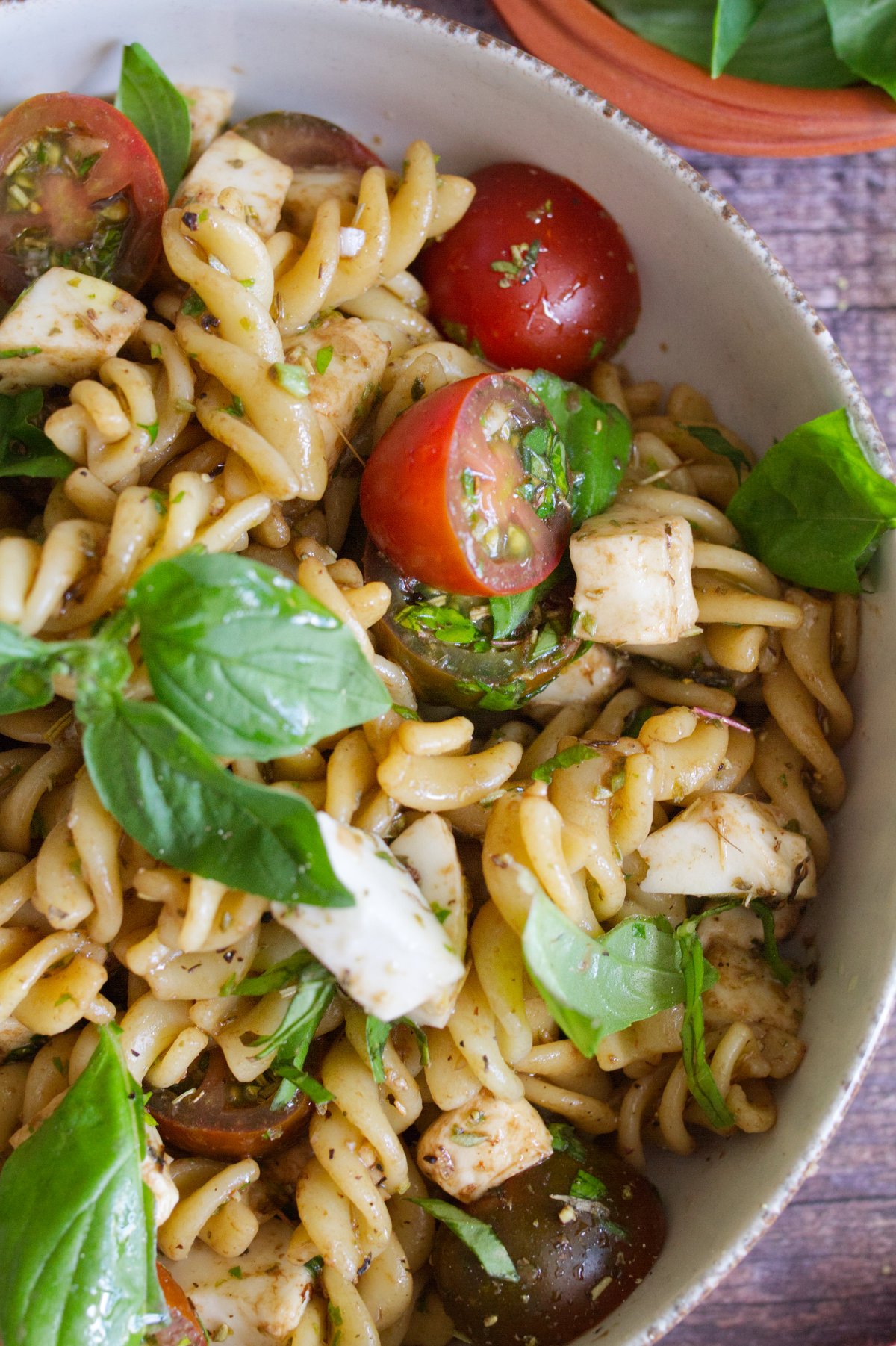
More Mediterranean Salad Recipes:
- Beet and Quinoa Salad with a Lime and Mustard dressing
- Mediterranean Pasta Salad + Tangy Lemon Herb Vinaigrette | Easy 20-Minute Recipe
- Fresh & Healthy Horiatiki Greek Salad + Easy Dressing Recipe
- Tabbouleh Salad Recipe: Light, Refreshing, and Delicious
- Classic Greek Salad with Kalamata Olives and Feta Cheese (Easy 5-Minute Recipe)
- Watermelon Salad with Feta Cheese (Easy Summer Salad Recipe)
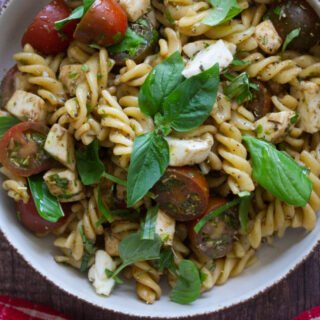
Caprese Pasta Salad (Insalata di Pasta Caprese)
Equipment
- Cooking pot with lid
- large glass bowl
- Cutting board and Chef Knife
- Salad Serving spoons
- Salad Serving platter
Ingredients
Caprese pasta salad
- 8 oz. 220g dry pasta (We used fusilli (spiral) pasta)
- 8 oz. 220g mozzarella (fresh cubed mozzarella or mini mozzarella balls)
- 2 cups cherry tomatoes halved
- 1 /4 cup fresh basil leaves finely chopped
- Salt and pepper to taste
Vinaigrette dressing
- 1 /4 cup olive oil
- 1 tbsp balsamic vinegar
- 2 tbsp fresh lemon juice around 1 lemon
- 1 clove of garlic minced
- 1 tsp Italian seasoning
- Salt
- Black pepper
Instructions
Step 1 – Cook Fusilli Pasta
- Cook the fusilli pasta according to package instructions. It should take around 9 minutes to become al dente once submerged in boiling water (make sure the water is boiling before adding the pasta).8 oz. 220g dry pasta (We used fusilli (spiral) pasta)
- Remove pasta from the heat and drain in a colander. Rinse with cold water for a minute or two or until the pasta is cool enough to touch.
- Drizzle with a splash of olive oil and mix through (this stops the pasta from sticking together while we prepare the salad and dressing)
- Set pasta aside to cool.
Step 2 – Prepare Vinaigrette dressing
- NOTE: Prepare the Vinaigrette dressing before making the salad so it gives plenty of time for the ingredients to meld.
- In a small bowl, Squeeze the juice from 1 lemon.2 tbsp fresh lemon juice
- Add the olive oil, balsamic vinegar, minced garlic, herbs, and seasoning. Give everything a mix for 30 seconds or until the ingredients combine.1 /4 cup olive oil, 1 tbsp balsamic vinegar, 1 clove of garlic, 1 tsp Italian seasoning, Salt and pepper
Step 3 – Prepare Salad
- Add the cooled pasta to a large bowl.
- Halve cherry tomatoes and add to the bowl.2 cups cherry tomatoes
- Chop the mozzarella into small cubes around half an inch (1cm). Add to the bowl with the pasta8 oz. 220g mozzarella (fresh cubed mozzarella or mini mozzarella balls)
- Finely chop around half of the basil leaves and add to the salad ingredients1 /4 cup fresh basil leaves
- Drizzle the dressing over the salad ingredients and mix well with salad tongs.
- Loosely scatter the remaining basil leaves on top of the salad. Season to taste and serve.Salt, Black pepper
Video
Notes
Cooking Tips:
- Don’t leave your pasta to soak in cool water as it will absorb liquid and become mushy. Give it a light rinse under cool water, and then set aside in a colander with just a splash of olive oil mixed in.
- Don’t have Italian seasoning? See the information in the article on how to make your own.
- Mozzarella pearls are also great for this recipe.

